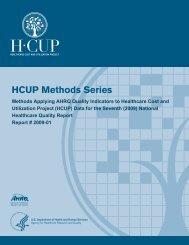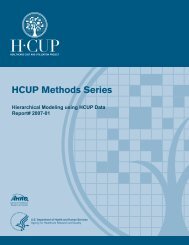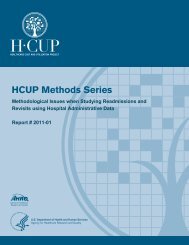Observation Status Related to U.S. Hospital Records - HCUP
Observation Status Related to U.S. Hospital Records - HCUP
Observation Status Related to U.S. Hospital Records - HCUP
Create successful ePaper yourself
Turn your PDF publications into a flip-book with our unique Google optimized e-Paper software.
separate data set on observation status patients from hospital emergency andoutpatient departments in Massachusetts. There are no national studies on the issue.In the <strong>HCUP</strong> inpatient and outpatient databases, we found that the percent of recordswith observation services varied considerably across States. In five States inpatientdatabases with observation status codes, the percent of the States' inpatient dischargeswith observation services ranged from 0.5 <strong>to</strong> 6.2 percent per year. In four <strong>HCUP</strong> Stateoutpatient databases, the percent of the States’ outpatient records with observationservices ranged from 0.4 <strong>to</strong> 8.0 percent per year. There was little variation in the codingof observation services across discharge quarter in both the inpatient and outpatientdatabases, but there was great variation among hospitals. <strong>Hospital</strong>s coded observationservices on 0% <strong>to</strong> 40% of their inpatient records, 0% <strong>to</strong> 70% of their ambula<strong>to</strong>ry surgeryrecords, and 0% <strong>to</strong> 30% on their emergency department records. In a number ofStates, many hospitals coded no observation services on their inpatient and/oroutpatient records.We further explored the <strong>HCUP</strong> data for internal consistency on observation status andfor whether hospitals typically count pre-admission observation days as part of theinpatient length of stay. For inpatient discharges without any observation servicescoded, we expected <strong>to</strong> find the length of stay equal <strong>to</strong> room and board days. We foundthat 1 <strong>to</strong> 10 percent of those discharges, depending on the State, did not havecongruence between length of stay and room and board days. For inpatient dischargeswithout any observation services, when the length of stay was not equal <strong>to</strong> room andboard days, length of stay was usually just as likely <strong>to</strong> be "greater than" as opposed <strong>to</strong>"less than" R&B days. For inpatient discharges with observation services, length of staywas more likely <strong>to</strong> be greater than the room and board days, suggesting tha<strong>to</strong>bservation services are at least sometimes included in the inpatient length of staycalculation by the hospital. However, when days in observation status were added <strong>to</strong>room and board days, the length of stay was still more likely <strong>to</strong> be greater than the sum.This suggests that either other services are being counted in length of stay or the daysfor room and board and/or observation services are not accurately captured on thedischarge record in the revenue codes and units.We also examined the length of stay on outpatient records. We found that not allemergency department and ambula<strong>to</strong>ry surgery visits of more than 24 hours haveobservation time associated with them. This suggests that not all of the time inobservation status is coded on the outpatient record in the revenue codes or there isanother categorical definition that applies <strong>to</strong> these cases.Because of these internal inconsistencies, we do not recommend further analysis ofobservation services with <strong>HCUP</strong> inpatient and outpatient databases. It is not possible <strong>to</strong>determine whether the variation in percent of inpatient and outpatient discharges withobservation services is because of practice differences in the use of observationservices or because observation services are not recorded consistently in the revenuecodes. Further, we caution analysts that inconsistent use and coding of observationservices may affect findings in studies of inpatient utilization for some conditions.ii
















